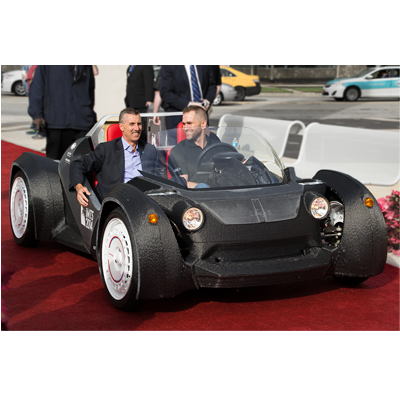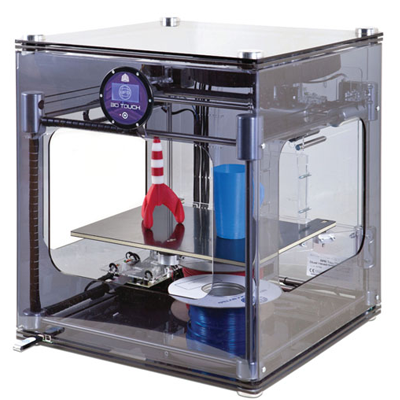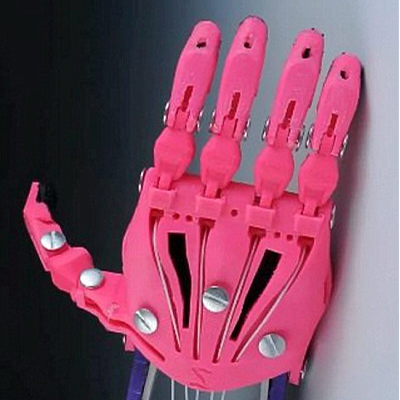8 Things You Can Print with a 3D Printer
Just a few years ago, few people had heard of 3D printing, but now computer generated images are being used to create cars, guns and even body parts. 3D printers work by laying down threads of melted polymer that add up to precisely-shaped solid objects just as easily as a traditional inkjet printer lays ink on a page.
3D printing is generating a lot of buzz in the world of technology, but at the moment it is hard to see how flimsy plastic models produced on consumer 3D printers can be an alternative to standard manufacturing processes. But here are 8 things that have been printed using a 3D printer, ranging from ground breaking to obscure.

1. 3D Printed Car
Arizona based car manufacturer Local Motors have created the world first fully functional, 3D printed electric car, made using just 49 parts as opposed to a traditional cars 5000 parts.
The Strati, which is Italian for layers, measures 3ft by 5ft by 10ft and has chassis body made of one solid piece with a top speed of 40 mph. It should be noted that the tyres, wheels, battery, wiring, suspension, electric motor and window shield were made using conventional methods.
The battery-powered, two-passenger car is made of layers of black plastic and reinforced with carbon fibre. Local Motors hopes to offer 3D-printed cars for around £11,000 in the near future. The manufacturing process is less expensive and it is hoped the car will bring innovations to the market, speeding up the usual methods of production.
2. 3D Printed Ears for Disfigured Children
In the first trial of its kind, Scientists at the University College London are using 3D printers to create ears that can be implanted onto children with severe disfigurements. The process has been initially tested by implanting 3D ears onto rats.
This major medical breakthrough could radically change organ transplants. The next stage is to trial the operation in India where there is a waiting list of dozens of children waiting to undergo the surgery.
3. 3D Working Gun
The worlds first 3D printed gun, named The Liberator, is rendered entirely in plastic. Fifteen of the guns sixteen pieces have been printed using a Stratasys Dimension SST 3D printer. The only part not produced by the 3D printer is the firing pin.
The Liberator is a fully functioning firearm, however, the type of plastic used is very dependent. For example, the gun has been printed using a plastic called Visijet, and this exploded under testing. The 3D gun, when rendered in a stronger plastic such as ABS, can shoot eight rounds without any problems. The weapon was found to have enough power to penetrate several inches of flesh as well as a human skull.
Despite this feat of engineering, authorities are concerned over the detectability of the 3D printed guns. Because it’s made of plastic, it can obviously not be detected by metal detectors, making it a potential security risk.

4. 3D Human Heart
Surgeons at a New York hospital have recognised 3D printing with helping to save the life of a 2 week old baby who needed complicated heart surgery.
The surgeons at Morgan Stanley Children’s Hospital used MRI scan data to print a copy of the child’s heart, finding the heart to be damaged with holes as well as having an unusual structure.
A surgery of this type is especially complicated and dangerous, but thanks to the 3D printer, the printed heart provided surgeons the chance to study the organ and develop a strategy, using the 3D printed heart as a map.
Dr Emile Bacha, the surgeon who performed the surgery, described the hearts unusual formation as being ‘like a maze’. Dr Bacha went on to say: “In the past we had to stop the heart and look inside to decide what to do. With this technique, it was like we had a road map to guide us. We were able to repair the baby’s heart with one operation.”
5. 3D Printing in Modern Medicine
While the US is pioneering the use of 3D printing in biomedical research, the NHS is exploring the use of 3D printing in modern medicine. Replica 3DM, a Wiltshire-based 3D printing company has provided 12 NHS Trust Hospitals with 3D printer stations, designed to help create and print replica hips for surgeons to practice hip replacement surgeries.
Last month, a scientist at Nottingham Trent University used 3D printing to produce a prosthetic human heart, which has been described "as close as you can get" to the real thing.
6. A Machine Gun That Prints and Fires 3D Aeroplanes
Dieter Michael Krone is a Düsseldorf-based mechanical engineer with a passion for paper aeroplanes who has created an unusual application of 3D printing. Nicknamed the A6 v1.0, Krone has created a machine gun that 3D prints paper aeroplanes and then fires them.
Like a conventional inkjet printer, it holds a stock of paper which. But then, instead of using ink cartridges to print onto the paper, is folds the paper, sheet by sheet into paper planes and then fires them. Although it is easy to dismiss Krones invention as pointless, it is at least a good highlighter of the potential of 3D printing. "A little tinkering from me that shows what you can do with 3D printers today.” Said Krone

7. 3D Printed Prosthetic Arm
Hayley Fraser, a five year old born with symbrachydactyly - a congenital abnormality which left her without any fingers on her left hand, is now the first child in Britain to get a 3D printed prosthetic. Previously, Doctors only offered the family an operation to transplant a toe to her hand.
The family discovered the not-for-profit group E-Nable, which introduced them to University of Wisconsin engineer Frankie Flood. Unlike traditional prosthetics, the 3D printed hand costs just £50, and is deliberately bold and colourful, designed to help disabled children feel proud for being different.
The process was simple, the Frasers made a plaster cast of Hayley’s arm and sent it to Professor Flood, he then printed the parts on a 3D printer, and then six weeks later, Hayley’s pink and purple bionic arm arrived in the post. The simple device is controlled by the wrist and wiring, and it provides not only function to disabled children, but also boosts self-esteem.
8. 3D Ice Cream
Students from the Massachusetts Institute of Technology have created a 3D ice cream printer, combining a Solidoodle 3D printer and Cuisinart ice cream maker into a single device, creating a device that offers on-demand soft ice cream printing.
The system is just a proof of concept, though the device is capable of printing shapes out of ice cream. Primarily, the 3D printer has been designed to get kids excited about technology.
"We were inspired to design this printer because we wanted to make something fun with this up and coming technology in a way that we could grab the attention of kids," said one of the students. "We felt that it was just as important to come up with a new technology as it was to interest the younger generation in pursuing science and technology so we can continue pushing the limits of what is possible." The team hopes that the technology eventually finds its way into ice cream shops as a fun option for kids.
It’s hard for a lot of people to see past the seemingly pointless 3D printing of things like ice cream and paper planes. But 3D printing is still in its infancy. Like a child, new technology needs to play and experiment in order to develop. There is a lot of patience and trial and error involved before innovations can mature into fully functional mainstream products or processes. For example, the first computer filled an entire room and did not even have the processing power of today’s most basic calculator, but it had to begin somewhere, and so does 3D printing.
For 3D printing to be a genuine alternative, more well-known brands need to incorporate 3D printing into their products. For example, WertelOberfell have created some 3D printed custom covers for the Panasonic Lumix GM1 camera. The idea being that people are able to purchase custom built products that meet their own specifications easily. You can read more about 3D printing on the high street here.
Posted by Wayne Hogan
































